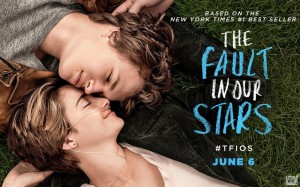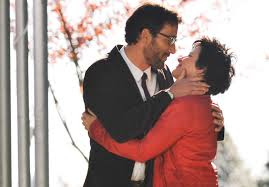The Fault in Our Stars
Posted on June 5, 2014 at 6:00 pm
 John Green’s best-selling novel, The Fault in Our Stars
John Green’s best-selling novel, The Fault in Our Stars is the story of kids with cancer, but it is not about dying. It is about living. This exquisite adaptation is that rare film based on a beloved novel that does full justice to the source material without being static or talky. The screenplay is by Scott Neustadter and Michael H. Weber, who showed exceptional sensitivity in the bittersweet love stories “(500) Days of Summer” and “The Spectacular Now” (also adapted from a beloved YA book and also starring Shailene Woodley), and it was directed by Josh Boone, of the underrated “Stuck in Love” (also starring Nat Wolff, who appears here as a friend of the central couple).
Remember the hospital scene in “Terms of Endearment?” This one will make you cry more. But it is sad, not depressing.
Woodley plays Hazel Grace Lancaster, whose lungs have been badly compromised and who cannot breathe without a nasal cannula attached to an oxygen tank. Pushed by her mother to attend a support group that meets “literally in the heart of Jesus,” with a guitar-strumming leader who is well-intentioned but unwilling to acknowledge the direness of the circumstances, Hazel catches the eye of lanky Augustus Waters (Ansel Elgort, and yes, he played her brother in “Divergent”).
She’s the nerdy girl, he’s the basketball-player and cool guy, which is the classic high school movie romantic setup for opposite attraction except in this case what they have in common is more important than what table they would sit at in the school cafeteria. He is not playing basketball anymore because his leg was amputated due to cancer. What brings them together is not the cancer but the shared worldview they developed as a result of the cancer, with few illusions but an openness to hope, if not hope for a longer life, at least hope for a better life. Hazel worries that she is “a grenade,” that the most significant impact her life will have is the devastating grief she leaves behind.
Hazel and Augustus exchange favorite books. His is a novelization of a video game. Hers is an ambitious, literary novel by a reclusive author named Peter Van Houten (Willem Dafoe, superb in a tricky role). The book ends abruptly, in the middle of a sentence, when its main character dies, and Hazel is overcome with curiosity about what happens to the characters she left behind. For all they have lost, they still have “cancer perqs,” privileges that come with the combination of pity and guilt felt by people around them. Augustus takes advantage of his to help Hazel meet Van Houten. But it is in the other parts of the journey that they find more important answers and better questions as well.
The characters in the movie like to say, “it’s a metaphor,” but their own story is a metaphor about the issues we all grapple with. Watching people whose biggest problem should be what to wear to the prom confront the problem of making sense of life, finding meaning, risking intimacy is a heightened version for dramatic purposes. But these are the core challenges for all of us, whether our lives will last for 16 years or 116. These teenagers just do not have the luxury the rest of us do of being in denial about how little time there is.
Elgort is marvelous, but then he gets to say swoon-worthy lines like “You realize that trying to keep your distance from me will not lessen my affection for you. All efforts to save me from you will fail.” On the other hand, he has the challenge of grandiloquent lines like. “It would be a privilege to have my heart broken by you,” and he says them beautifully. Woodley is in every way (except literally) the heart of the film, and once again delivers a performance of endless sensitivity, even with a cannula in her nose. Fans of the book will find key scenes like the egging of a car and the ultimate romantic restaurant date exactly as they envisioned it. Even the trip to the Anne Frank house, which could have been heavy-handed, is handled well. Anne Frank is, in a way, the spiritual sister of Hazel and Augustus. Like them, she had to find meaning in the midst of devastation. As they walk through the hidden annex where she lived, her words of hope come out of tinny display speakers. And Hazel’s climb up the steep steps to see it is itself a “shout into the void.”
I like the way they call each other by their full names. Even though their time is limited, addressing each other with a touch of formality and grandeur is too important for short cuts. I like the intensity and honesty of their talks; anything less they know they do not have time for. The title comes from Shakespeare’s “Julius Caesar.” The nobleman Cassius says to Brutus: “The fault, dear Brutus, is not in our stars,/But in ourselves, that we are underlings.” He is saying that it is we who determine how we live. But the line that I think of when I see this film is from poet Rabindranath Tagore, who wrote, “The butterfly counts not months but moments, and has time enough.”
Parents should know that the theme of the film is teenagers with cancer. Many characters are very ill and there is a very sad death, as well as brief strong language, sexual references and situation, teen drinking and adult alcohol abuse.
Family discussion: What questions would you like to ask an author about a book you like? How should you choose who will hurt you? What makes some infinities larger than others?
If you like this, try: the book by John Green and the films “Harold and Maude” and “Restless”

